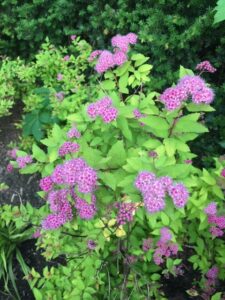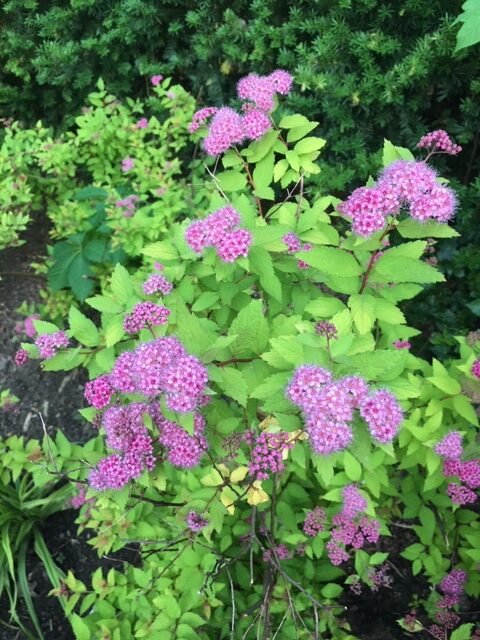June 6th
The 157th Day of the Year
Vast overhanging meadow-lands of rain,
And drowsy dawns, and noons when golden grain
Nods in the sun, and lazy truant boys
Drift ever listlessly down the day,
Too full of joy to rest, and dreams to play.
James Whitcomb Riley
Sunrise/set: 5:07/8:01
Day’s Length: 14 hours 54 minutes
Average High/Low: 79/58
Average Temperature: 69
Record High: 97 – 1925
Record Low: 41 – 1998/43 – 1894
Weather
This is one of the four driest days in June (the 10th, the 25th, and the 26th are the others), and rain passes through only once or twice in a decade. Skies are clear 80 percent of the time, and the likelihood of temperatures in the 90s rises to 25 percent for the first time this year. Eighties occur 30 percent of the years, 70s forty percent, and there is only a slight possibility for cool 60s.
Natural Calendar
In the shade, fire pink and honewort are flowering. At the edge of the forest, wild plants include blue-eyed grass, silver yarrow, yellow sedum, moneywort, daisies, yellow sweet clover, wild roses, wild iris, dock and smooth brome grass. Oaks and black walnut trees and Osage orange have set their fruit. There are bud clusters on the milkweeds, buds on the delicate touch-me-nots, buds on the giant blue hostas, buds on the yucca, the purple coneflowers, the mallow, the balloon flower and the gayfeather. Young grackles join their parents to harvest the ripening cherries and mulberries. Painted turtles are laying eggs. The fearsome (but harmless) stag beetle waddles to porch lights after dark. Baby robins have been out for a week or two.
Daybook
1982: Old-field cinquefoil blooming now, vetch, lesser stitchwort, white campion, first Canadian thistle, bindweed by Ellis Pond. Red-winged blackbirds still nesting in the wheat. By the swinging bridge, most of the watercress has gone to seed, replaced by wild forget-me-nots.
1983: Mill habitat: Sweet rockets and golden Alexander still dominate. Garlic mustard, ragwort, fleabane are gone, honeysuckles are fading, along with the tall buttercups. Nettles and grass waist high, tangled with catchweed (flowers turned to burs), make it hard to leave the path. Fire pinks still strong, clustered snakeroot full. Rockets, parsnip, clover, chickweed, and bright yellow goat’s beard color the field. Some waterleaf and wild geranium still blooming.
1986: Peak of strawberries in the yard. First third of a pint of black raspberries picked.
1991: Balloon flower opens in the south garden. At Caesar Creek, the far fishing hole: one bass, one catfish, one bluegill.
1992: On the road: Peonies open in Madison, Wisconsin, not yet in Crookston, Minnesota, gone in Chicago. First crown vetch seen as I came south through Normal, Illinois. Throughout the lower Midwest, it’s peak parsnip and yellow clover time. Uncle Bill reported hummingbirds had come to Gentilly, Minnesota, two miles from Crookston, the last week of May, pretty much on schedule.
1993: At four in the morning, birds quiet except twittering down the block. Cherries ripening a very little, some pale and yellowing, some a shade of orange. Mock orange petals dropping. Snow-on- the-mountain is full. Full sweet clover and wild roses, very first nodding thistle south of Kettering, the Canadian thistles about ready. White moth or butterfly (like a Pieridae) seen in the grass, then again on the front porch.
1998: Record low of 41 this morning. Early Summer stagnates.
1999: First black cricket hunter seen, last swamp iris bloom. First earwig in the bathroom.
2001: Catalpa flowers falling at Antioch School. Very last columbine in the east garden. Coral bells full bloom. Rockets, daisies and ranunculus fading quickly. Strawberries down to the last few pickings. Tadpoles, some with legs, released into the pond.
2004: Peak of mayfly hatch at the Santee Cooper reservoir in South Carolina. Blue-flowered pickerel plant in full bloom with the water willow. Learned that catfish mate when the water reaches 60 degrees and that they go on a feeding frenzy when the mussels die in the heat of early June.
2005: First pink spirea seen at school in Washington Court House. Pale-leaved spirea flowering downtown in Yellow Springs. First coreopsis and foxglove open at home, coreopsis seen full bloom along the freeway, foxglove just off Limestone Street. Wheat pale gold along the roads close to the Ohio River. Peonies declining, mock orange suddenly collapsing in the heat. Privets coming in. Spinach and radishes going to seed.
2006: Return from Kelleys Island, elderberries seen opening by the roadside in northern Ohio. At home, strawberries still not ripe, some rotting from the rain. Early panicled dogwood in the alley, full Japanese honeysuckle, lollypop lilies, white penstemon, privet. Some black mulberries starting to fall near Lawson Place and in the alley. Birds loud in the yard through the early evening, grackle families feeding together, the young – as big as the parents – demanding to be given food as they walk together in the lush grass. Lettuce holds in the garden, but the rhubarb is prostrate, the first crop gone, the second growth April size.
2007: Jeanie and I went strawberry picking today, got eight pounds. The man said the crop had started to come in just about ten days ago and that it would be gone in just a few more days. It was the hot weather, he said, that accelerated the season, cut it in half. Out in the countryside, the wheat was tall and gold-green. Some corn was knee high. In the back yard this morning, the grackles and sparrows were back, babies pursuing their parents, screaming for food.
2008: Japanese honeysuckle has been blooming about two days now. Osage flower clusters have been falling about the same length of time. Early privet along High Street, snow-on-the-mountain full at Gerard’s, starting here. A definite change in the grackles’ habits – the yard much quieter. Cedar waxwings still sing in the white mulberry tree. Cardinals and robins still call. Full catalpa blossoms along the highway north of town – catalpas and Japanese honeysuckle coming together. The pale violet pond iris is at its peak, will probably be gone tomorrow.
2009: Red-bellied woodpecker calls steadily. Early astilbe, white-flowered waterleaf, and coral bells at full bloom. Grackles and starlings clucking throughout the day. This evening, Rick told me about seeing grackles spitting out white fecal matter into the birdbath. Jeanie and I had seen the evidence of that but had not observed it. No cedar waxwings yet this year.
2010: Walking Bella this morning, I found an Osage fruit fallen to the sidewalk, maybe half the size of a golf ball, small adolescent hairs all over its bumpy skin. The deer came back twice today while I was working at the shop. Jeanie had to scare it away both times. Tonight we watched fireflies in the circle garden. Tornadoes in northern Ohio last night.
2011: Italy: Linden trees in Spoleto finally flowering.
2012: Finches have been feeding heavily and in considerable numbers this past week. Hemlock going to seed all along the road to Xenia, the year continuing to be ahead of almost all the other years. Bi-colored hosta blooms in front/east side of the house, and another blue on the north side. Near Lawson Place, cottonwood cotton fills the side of the road.
2014: Don’s oakleaf hydrangea has started to open and a few of his pie cherries are reddening. All of the honeysuckle flowers are down and all of the catalpas are in full bloom throughout the neighborhood. A newly emerged orange polygonia visited the garden, and I found milkweed beetles mating on the two milkweed plants that Rick had brought last year. Wild grapes the size of BBs. Late Kousa dogwood noticed in the park. And Ann Randolf called this morning from Stewart Drive, reacting to my lament a few days ago about not seeing cedar waxwings in my mulberry trees and about the lack of butterflies in the yard: She had seen cedar waxwings last Friday (May 30th), seven on one serviceberry bush. On the 28th, she had watched as one waxwing took a berry, put it in the mouth of another, and the birds passed the fruit back and forth maybe ten times. She said she had seen them in pairs feeding throughout the last week of May. Then, she added that she had seen a monarch and a tiger swallowtail and a sulphur in the honeysuckles, and two brown thrashers after the rain on June 4th.”
2015: Some of Peggy’s pie cherries are ripe, nice and sweet. One heliopsis flower unraveling, catchweed burs catch on my pant legs, linden trees with berries. Measuring fruit time: peaches and apples at about a fourth, grapes bigger than BBs, local strawberries in the prime of their season. At the women’s park near Glen Helen, long plantings of heliopsis and purple coneflowers have just begun to flower. A clump of baptisia has gone to seed, only a couple of blossoms left. Cup plant shoulder high. Timothy soft for chewing by the parking lot.
2016: Two bright yellow Asiatic lilies opened downtown. The pond Japanese iris is in early to middle bloom, deep rich purple as always. The hydrangea season has begun with the whitening of petals on the Annabelle and hobblebush, early bloom on the oakleaf, buds showing a little pink on the Indomitable Spirit.
2017: The first two ditch lilies seen this morning on Dayton Street. Early flowers noticed on the hobblebush, several oakleaf hydrangeas in flower, Indomitable Spirit hydrangea showing pink. Twelve stella d’oros in bloom. Earliest chicory seen near the high school. Full bloom of Anna Belle hydrangeas along Dayton Street, catalpas mostly fallen on South College Street, yuccas tall and budded, daisy fleabane full bloom in Tony’s field. A few more orange lilies this evening.
2019: From the foothills of Umbria, Italy, Neysa reports the ginestra bush (Ginestra racemosa or Cytisus recomosus) or Broom Plant is in full bloom and that its fragrance is wonderful. She also said she saw a family of wild boars crossing the road near her house: a mother, seven piglets followed by another large adult boar.
2020: First stella d’oro lilies seen open across from the Village Artisans store downtown. On the highway north, a long drift of full-blooming yellow sweet clover. Cottonwood falling in clumps along North High Street. Near my studio, Osage leaves have finally formed and the Osage flowers trickle down to the hostas and the great burdock basal foliage.
The word for “nature” in Chinese comes from Daoism and means “things as they are” or “things as they are spontaneously” So “nature” is a philosophical principle in a way rather than just the things you perceive in the landscape.
Sunsook Hong Setton


